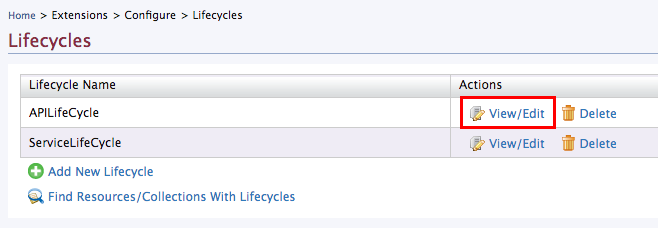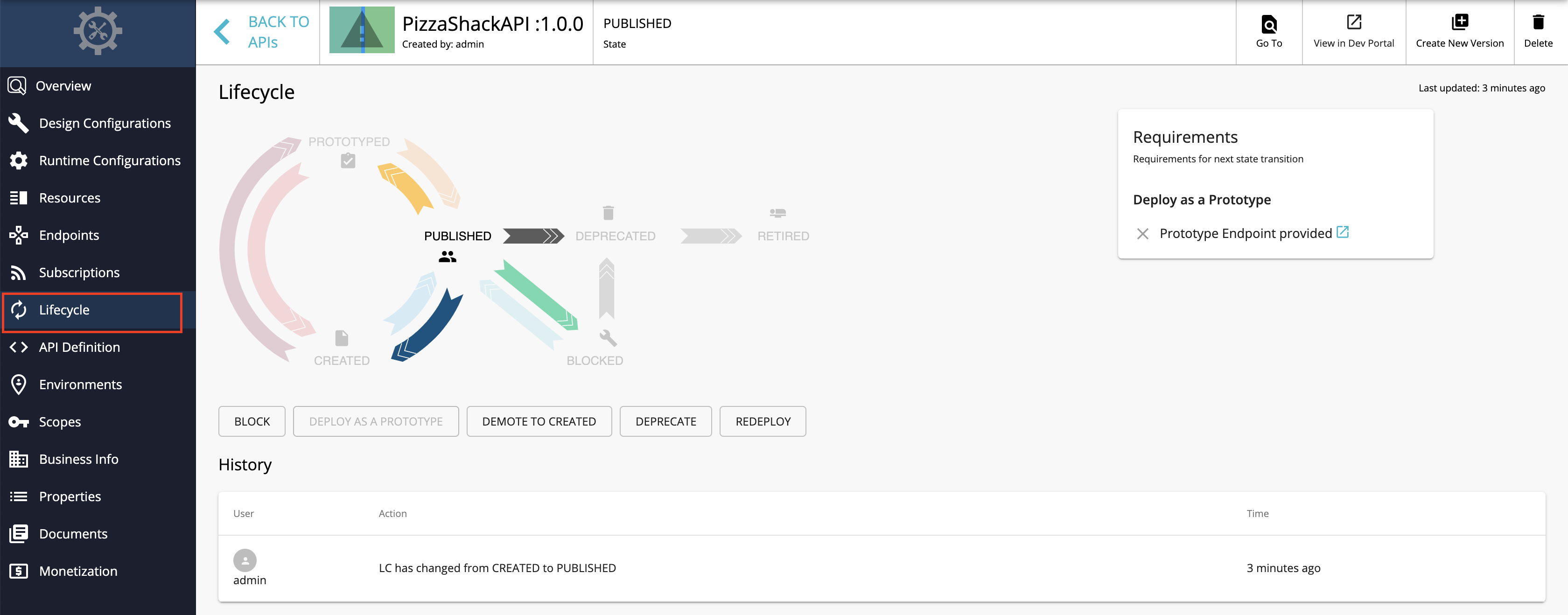Extending the API Life Cycle¶
Default API Lifecycle in WSO2 API Manager¶
The WSO2 registry based life cycle provides a configurable way to define the life cycle of an artifact, which can be extended easily, as the default API life cycle is defined as an XML configuration.
To see the default API life cycle configuration, follow the steps given below.
-
Start the API Manager server and log into the management console: https://localhost:9443/carbon.
-
Navigate to Extensions > Configure > Lifecycles.

-
Click the View/Edit link corresponding to the API LifeCycle. The default API life cycle configuration opens.
The above configuration includes the following important information:<aspect name="APILifeCycle" class="org.wso2.carbon.governance.registry.extensions.aspects.DefaultLifeCycle"> <configuration type="literal"> <lifecycle> <scxml xmlns="http://www.w3.org/2005/07/scxml" version="1.0" initialstate="Created"> <state id="Created"> <datamodel> <data name="checkItems"> <item name="Deprecate Old Versions" forEvent=""> </item> <item name="Require Re-Subscription" forEvent=""> </item> </data> <data name="transitionExecution"> <execution forEvent="Deploy as a Prototype" class="org.wso2.carbon.apimgt.impl.executors.APIExecutor"> </execution> <execution forEvent="Publish" class="org.wso2.carbon.apimgt.impl.executors.APIExecutor"> </execution> </data> </datamodel> <transition event="Publish" target="Published"/> <transition event="Deploy as a Prototype" target="Prototyped"/> </state> <state id="Prototyped"> <datamodel> <data name="transitionExecution"> <execution forEvent="Publish" class="org.wso2.carbon.apimgt.impl.executors.APIExecutor"> </execution> <execution forEvent="Demote to Created" class="org.wso2.carbon.apimgt.impl.executors.APIExecutor"> </execution> </data> </datamodel> <transition event="Publish" target="Published"/> <transition event="Demote to Created" target="Created"/> </state> <state id="Published"> <datamodel> <data name="transitionExecution"> <execution forEvent="Block" class="org.wso2.carbon.apimgt.impl.executors.APIExecutor"> </execution> <execution forEvent="Deprecate" class="org.wso2.carbon.apimgt.impl.executors.APIExecutor"> </execution> <execution forEvent="Demote to Created" class="org.wso2.carbon.apimgt.impl.executors.APIExecutor"> </execution> <execution forEvent="Demote to Prototyped" class="org.wso2.carbon.apimgt.impl.executors.APIExecutor"> </execution> </data> </datamodel> <transition event="Block" target="Blocked"/> <transition event="Demote to Prototyped" target="Prototyped"/> <transition event="Demote to Created" target="Created"/> <transition event="Deprecate" target="Deprecated"/> <transition event="Publish" target="Published"/> </state> <state id="Blocked"> <datamodel> <data name="transitionExecution"> <execution forEvent="Re-Publish" class="org.wso2.carbon.apimgt.impl.executors.APIExecutor"> </execution> <execution forEvent="Deprecate" class="org.wso2.carbon.apimgt.impl.executors.APIExecutor"> </execution> </data> </datamodel> <transition event="Deprecate" target="Deprecated"/> <transition event="Re-Publish" target="Published"/> </state> <state id="Deprecated"> <datamodel> <data name="transitionExecution"> <execution forEvent="Retire" class="org.wso2.carbon.apimgt.impl.executors.APIExecutor"> </execution> </data> </datamodel> <transition event="Retire" target="Retired"/> </state> <state id="Retired"> </state> </scxml> </lifecycle> </configuration> </aspect> -
Lifecycle name: APILifeCycle.
-
Set of six default states:
- CREATED
- PROTOTYPED
- PUBLISHED
- BLOCKED
- DEPRECATED
- RETIRED
-
Set of checklist items to be satisfied. For example, when the API is in the CREATED state and has multiple versions, there are two checkist items that needs to be provided when changing the lifecycle state to Publish.
- Deprecate old versions
- Require re-subscriptions
-
State transition events: Defines from which state to which target state an API can be moved.
-
Actions for each state transition: A triggered action that executes during each state transition. For example, when an API state changes from CREATED to PUBLISHED , an execution occurs as a relative synapse API where an XML element is created and the related API data is saved in the database. This execution is defined for each state transition in the above registry life cycle configuration.
The state transition events that occur in the default API life cycle is shown in the following diagram:

The Lifecycle tab shows the current state of an API, the target events defined in the API life cycle for that state, and the set of checklist items.

Info
This UI is static in the default stage and need to customize the lifecycle diagram to add any custom lifecycle state.
If you customize the default API life cycle configuration including states, transition events or check list items, those changes are updated in the Lifecycle tab of the Publisher UI accordingly.
Extension Points of API Lifecycle¶
With the integration of the registry life cycle to the API life cycle of WSO2 API Manager, it is possible to extend the existing API life cycle and customize it according to your preference.
Tip
Consider the following points when extending and customising the API life cycle XML configuration.
- Do not change the life cycle name since it needs to be engaged with the APIs dynamically.
- Make sure you keep the PUBLISHED and PROTOTYPED states as those two states will be used by API Publisher in the API creation wizard.
Following are some extention points where the default API life cycle can be extended by modifying above mentioned XML configuration of the API life cycle.
- Define your own life cycle states in the API life cycle
- Change the state transition events as per the environmental preferences
- Add custom checklist items for specific state transitions
- Change the execution code for each state transition
Info
For all state transitions, the same execution class is used ( org.wso2.carbon.apimgt.impl.executors.APIExecutor ). However, you can plug your own execution code when modifying the life cycle configuration.
For example, if you want to add notifications for a specific state transition, you can plug your own custom execution class for that particular state in the API life cycle. Any changes are updated in the Lifecycle tab accordingly.
For example, a transition event called Notify Users is introduced in the DEPRECATED state by modifying the default API lifecycle as follows,
<state id="Deprecated">
<datamodel>
<data name="transitionExecution">
<execution forEvent="Retire"
class="org.wso2.carbon.apimgt.impl.executors.APIExecutor">
</execution>
</data>
</datamodel>
<transition event="Retire" target="Retired"/>
<transition event="Notify Users" target="Retired"/>
</state>